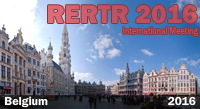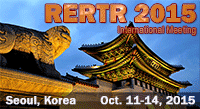Abstracts and Available Papers Presented at the
1997 International RERTR Meeting
"Designing a New Generation Fuel
Element for Different
Purpose Water Reactors"
A. Vatulin, V. Lysenko, A. Savchenko
State Science Center of Russian Federation
All-Russia Scientific Research Institute for inorganic materials (ARSRXIM)
Introduction
This report sets forth the main results of activities carried out at ARSRIIM in 1995-1996 within the framework of the project, financed by International Scientific and Technological Center.
The main goal of the project was the development of fuel element, which meets the following requirements:
-ability to work in a broad range of operational parameters of various water-water reactors in power changing modes;
-ability to ensure burn-up more than twice exceeding burn-up of usual fuel element of power reactors.
The goal was supposed to be achieved by developing fuel elements with porous dispersion cores. High thermal conductivity of dispersion cores was to ensure low operation temperature of a fission phase and fuel element. Consequently accumulated energy decreases and gas induced swelling does not follow. The uniformly distributed porosity should by means of core materials creep compensate the increase of the core volume which happens only because of nuclear fuel particles' hard swelling, and should provide the minimum change of the fuel element geometrical dimensions.
The final goal of the project was:
-to develop the designs and laboratory technologies for fuel elements manufacturing;
-to issue the design documentation on fuel elements for loop reactor tests.
Thus, fuel elements manufacturing technologies should provide:
-uniform distribution of nuclear fuel along the length and core section;
-uniform pore distribution along the length and core section;
-high thermal conductivity of cores and high effective thermal conductivity of fuel element as a whole;
-the capability to change uranium content of the core with the help of technological methods, as well as the use of materials with various uranium content;
-the capability to manufacture fuel elements of different sizes with various cladding forms of different materials.
In the course of research a great variance of design versions and fuel elements manufacturing technologies was considered. Some of them were rejected for different reasons, some have not been modified yet and will form the perspective basis.
Alongside with the development of designs and technologies, metallographic and thermal physics examinations were carried out. As well methods of fuel element quality control and a software package for calculation of the stress-strained conditions and shape changes of the fuel elements with porous or nonporous core were worked out. The report represents fuel elements designs and fabrication technologies, which we recommended for in-pile tests.
![]() PDF version NOT available
PDF version NOT available
An electronic copy of the full paper is not available at this time. If you would like
to receive a copy of this paper, please contact the author.
Contact:
Dr. A. Vatulin
VNIINM
Rogova 5, PO Box 369
Moscow 123060, Russia
Tel.: +7-095-196-4075
E-mail: [email protected]




